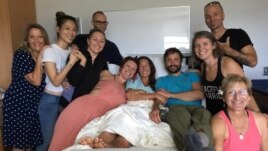29 June, 2019
Yesenia D'Alessandro added a global positioning system, or GPS, recording program to her mobile phone before entering a hard-to-reach Hawaiian forest.
She was joining more than 100 volunteers looking for a missing person.
D'Alessandro flew all the way from the state of Maryland to join the rescue efforts. The volunteers searched through dense plant life, crossed rivers and faced other environmental difficulties.
The group was searching for D'Alessandro's friend, Amanda Eller. She had disappeared last month.

Amanda Eller, a yoga instructor who went missing for 17 days while hiking in Maui's Makawao Forest Reserve, poses for a photo at Maui Memorial Medical Center in Hawaii, after she was rescued during a search operation, May 25, 2019.
"You have to search everywhere," D'Alessandro told the Associated Press.
She and others gathered GPS data of the ground they covered using apps on their phones. Organizers put that data on a special computer-based map to help better understand where they should look next.
In time, the technology led the volunteers to Eller. She survived for 17 days in the Maui forest by eating plants and drinking water from a small river. Her rescue shows how new technology helps rescue teams more effectively search the wilderness for missing people.
"It kind of led us to search outside of that high-priority area to where we actually found Amanda," said Amanda's father, John Eller.
In the United States, more teams are turning to the technology that combines mobile phone GPS with computer-based maps. This details waterways, underground areas and other hard-to-search places. It helps organize the work of large numbers of volunteers.
The system showed when Hawaii searchers had covered a three-kilometer radius around Eller's car. After that, searchers sent a helicopter deeper into the forest, where they found the 35-year-old woman.
Chris Berquist, a volunteer search leader, said the team would never have looked outside the area they thought she was likely in without the technology.
"There's no reason to start reaching further and further out of the box if we hadn't completely searched the box," he said.
David Kovar works for the nonprofit National Association for Search and Rescue. He said most search and rescue teams use computer-based maps. That could mean anything from Google Maps to specialized software called SARTopo. California search and rescue experts used SARTopo to advise the Maui volunteers from a distance.
Search organizers in Hawaii asked volunteers to download a low-cost app called GPS Tracks. It puts lines on a map showing where a user has walked.
GPS data showed that searchers were covering the same areas repeatedly as dense plant life or other natural barriers blocked their path, Berquist said. Organizers started dropping markers on volunteers' maps to give them targets. This pushed volunteers to cover more ground and made the search more accurate.
Matt Jacobs is a California software engineer and search volunteer. He developed SARTopo more than eight years ago after noting teams struggled to identify details on wilderness maps drawn by different agencies. What started as a project of personal interest has grown in popularity in the past few years to become Jacobs' full-time job. Search and rescue teams from Oregon to North Carolina have started using it.
Rescuers used it in March as 100 volunteers searched a Northern California forest, eventually finding 8-year-old Leia Carrico and her 5-year-old sister, Caroline.
SARTopo also is becoming available as a mobile phone app. This will make it even easier to directly connect the GPS data with computer-based maps so searchers can look at them wherever they are.
Government officials are looking at making use of new technology. Most large searches are done by volunteers because many places do not do enough of them to keep official teams employed.
Maui firefighters used hand-drawn maps as they looked for Eller over the first three days of her going missing. That is because the walking path system in the Makawao Forest Reserve where Eller went missing does not appear on Google Maps.
Mike St. John is a volunteer leader of the search and rescue team at the Marin County Sheriff's Office in California. He was among those who advised the Maui team. He said GPS recordings of where people have looked are very important.
"It's about using GPS maps and utilizing GPS to make sure you're hitting your assignment," St. John said.
St. John said his search and rescue experts are not always able to offer the same level of help to others that they gave to the group in Maui. But they are trying to find out how to be able to in the future.
Berquist, the Hawaii search leader, visited California this week to talk with St. John about how Marin County's volunteer program works. He aims to set up something similar back in Maui.
After technology helped find his daughter Amanda, John Eller donated software and other equipment to Berquist's team. He is also developing a search and rescue app and giving $10,000 to support Hawaii searches and rescues.
He said, "We feel so lucky with everything everybody did for us, so we're looking to give back."
I'm Susan Shand.
And I'm Pete Musto.
Audrey McAvoy reported on this story for the Associated Press. Pete Musto adapted it for VOA Learning English. Ashley Thompson was the editor. We want to hear from you. How else might technology help search and rescue teams in the future? Write to us in the Comments Section.
_______________________________________________________________
Words in This Story
app(s) – n. a computer program that performs a particular task
priority – n. the condition of being more important than something or someone else and therefore coming or being dealt with first
radius – n. an area that goes outward in all directions from a particular place
accurate – adj. free from mistakes or errors
utilizing – v. using something for a given purpose